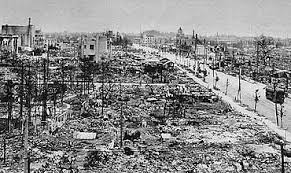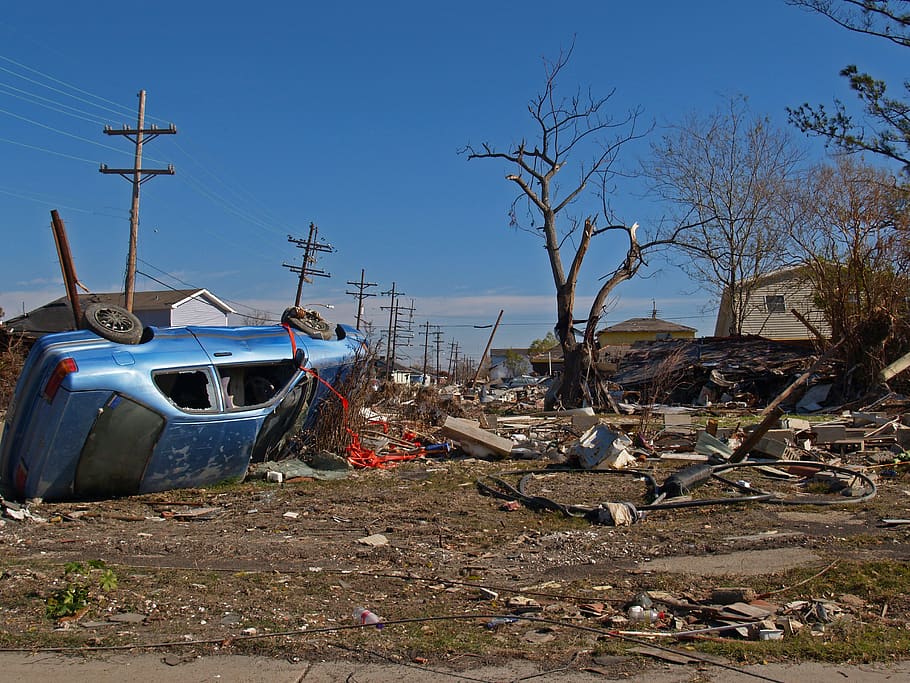キャプティブ 2023.08.10
CA53 関東大震災から100年目の現実
For those who prefer to read this column in English, the Japanese text is followed by a British English translation, so please scroll down to the bottom of the Japanese text.
関東大震災が発生したのは、1923年、大正12年であった。私の父が、旧満州大連で満鉄に勤務していた祖父のもと生まれた年であり、私の脳裏に深く刻み込まれている年でもある。本年、2023年9月1日は、未曾有の大災害と言われた、この関東大震災が発生してちょうど100年目となる。

1.関東大震災から100年
政府内閣府の公式WEBサイト、その「防災情報のページ」に掲載されている「災害教訓の継承に関する専門調査会報告書 平成18年7月 1923 関東大震災」には、関東大震災に関して、以下のような記述がある。(青色は筆者付加)
<第一編 発災とメカニズム>
第1章 被害の全体像
1923(大正12)年9月1日正午2分前に発生した関東大地震はマグニチュード7.9と推定される、近代化した首都圏を襲った唯一の巨大地震であり、南関東から東海地域に及ぶ地域に広範な被害が発生した。死者105,385、全潰全焼流出家屋293,387に上り、電気、水道、道路、鉄道等のライフラインにも甚大な被害が発生した。
第2章 地震の発生機構
関東大地震は、地殻を構成するプレート同士が、接触面で一気にずれ動くことにより生じた地震であって、震源域の近い地震としては元禄16(1703)年の元禄地震(推定マグニチュード8.2)があり、このような巨大地震の発生間隔は200〜400年と推定されている。
第3章 地変と津波
関東南部、特に神奈川県西部及び千葉県の房総地域においては、地震やその直後の大雨により、崩壊や地すべり、土石流などによる土砂災害が多数発生し、特に今の小田原市根府川では土石流により埋没64戸、死者406人という被害が発生したが、沖積低地や都心部の建物崩壊や火災の陰に隠れてあまり社会的関心をもたれなかった。
東京湾岸部の干拓地や埋め立て地、相模川、荒川、古利根川などの河川沿いの低地においては地盤の液状化が起こり、地盤の陥没や地割れ、建物の沈下、傾斜、地下水や砂の噴出などの現象が起こった。
相模湾周辺と房総半島の南端では最大高さ12m(熱海)、9m(館山)の津波が起こったが、各地で元禄地震や安政元(1854)年の東海地震の津波による災害経験が生かされ、地震直後の適切な避難行動により人的被害が最小限に食い止められた地域もあった。
第4章 揺れと被害
震度7の地域は震源近くに分布しているが、震度6弱以上の地域をみると、震源から離れていても1000年前の利根川、荒川の流路に沿って分布している。より細かくみると、かつての沼沢地や河川の流路だったところは震度が高くなる傾向がある。
地震により米国流や煉瓦造りのビルが倒壊したのに対して、日本流の耐震設計のビルが被害軽微であったことを契機として、地震の翌年の1924(大正13)年に市街地建築物法の構造強度規定が改正され、世界で初めての法令による地震力規定が誕生した。
当時日本列島には既に世界的にみてももっとも密度の高い地震観測網がしかれていた。濃尾地震を契機に設置された震災予防調査会は報告第100号を出して解散し、その事業は東京大学地震研究所に引き継がれたが、この報告書は後世も高く評価されている。
第5章 火災被害の実態と特徴
震災前の防火体制は人民保護を担う警察行政の一環とされてきた。消防組織は東京、横浜は専任の職員がおかれたが多くの地域はボランティア的な人々に担われていた。
装備は当時の最新のものがおかれていたが水源を水道に頼っており、断水と火災の同時多発には対応できなかった。
地震が昼食時に起こったこともあり竈(かまど)、七輪から同時多発的に火災が発生し、水道が断水したため最新の装備も役に立たず、おりからの強風によって火災はたちまち延焼し、消防能力を超えた。さらに避難者の家財などが延焼促進要因になった。逆に焼け止まりの原因をみると、破壊消防を含む消火活動や、広場や道路などの空地の効用がわかる。
火災被害では東京市の本所被服廠跡地の悲劇が有名であるが、その原因といわれる火災旋風についてはまだ研究すべき点が残っている。横浜市においても市街地全域が焼失し、石油タンクの火災は12日間も続いた。
おわりに 〜関東大震災(第一編)の教訓〜
・関東大震災は近代未曾有の大災害であったが、被害を食い止めた例の検討を通じて、数多くの教訓を得ることができ、後の災害対策の礎になったと評価できる。それらについてはこの後の第二編、第三編において取り上げることとし、ここでは例示にとどめる。
・伊豆、房総を襲った津波の被害が最小限にとどめられたのは、過去の災害教訓の伝承がなされていたことによるものであった。
・消防体制において、地震と火災といった複数の要因に対応し得る備えがなされるべきである。
・また、建物の耐震化、空間や緑地の確保などの災害に強いまちづくり、災害時に町内で助け合って被害を軽減するような共助の取り組みなどに平時から取り組んでおくことが重要である。

2.キャプティブの果たす意義
有力な「ノーベル賞候補」であった世界的な物理学者、寺田寅彦の言葉に、「天災は忘れた頃にやってくる」という言葉がある。
「天災は忘れた頃にやってくる」という教訓と反して、ある意味日本人を特徴付ける言葉としてよく使われるものに「喉元過ぎれば熱さを忘れる」があるが、関東大震災から100年経って、果たして「忘れた頃にやってくる天災」に対応する体制に日本はなっているのであろうか。それとも「喉元過ぎれば熱さを忘れる」ことになっているのであろうか。
「キャプティブ」は「リスクマネジメントの手段」である。リスクマネジメントとは、「弛まなく継続的に、リスクを洗い出し、検証し、対応していく作業」のことである。企業にとっては、「常にリスクと向き合う経営戦略」である。「喉元過ぎれば熱さを忘れる」ということを発生させない手段である。
キャプティブの効用には、「日本では求めることが難しい『世界基準の地震補償、巨額の地震保険補償』を得ることを可能にする」というものがあるが、この「弛まなく継続的に、リスクに接して、対応策を検討、実施するコアとなる」というキャプティブの別の効用にも目を向けるべきではないだろうか。
東日本大震災の時に使われた言葉、「想定外」を二度と口にしなくて済むようにしなければならない、「天災は忘れた頃にやってくる」からである。
今回のまとめ
京都大学の鎌田浩毅名誉教授が執筆した「首都圏直下地震と南海トラフ」(MdN新書)には、「日本列島が『動く大地となってしまった』」という言葉が幾度となく記されている。東日本大震災の発生によって、日本列島が大きく影響を受け、「動く大地となってしまった」ということである。
政府は、首都圏直下地震が起きた場合の被害予想は、最大で1万1000人の犠牲者、全壊、焼失家屋61万棟、95兆円の経済被害が出ると想定しているが、同名誉教授は、「東日本大震災によって事実上、東日本の内陸部では首都圏も含めて直下型地震が起きる確率が高まった、と考えた方がよいでしょう」と警鐘を鳴らしている。
日本は、地震・津波などの地震災害国であるにも関わらず、国内の損害保険会社が販売する一般的な地震保険商品では、企業が必要とする高額の補償を確保することは困難な状況が続いている。一方、海外の保険市場には、巨大な保険引受力(キャパシティ)が存在するため、国内の一般的な企業向け地震保険商品では提供できない高額の補償を廉価で得ることができる可能性が高い。
日本損害保険協会の行動規範には、「安心かつ安全で持続可能な社会の実現と、経済および国民生活の安定と向上に資する相互扶助制度を円滑に運営することが、損害保険事業の社会的使命として求められている」とある。
つまり、損害保険会社はその社会的使命として、「ある特定の一社にのみ補償を提供することではなく、日本国内の個人、企業に遍く広く補償を提供すること」が求められている。「一社のみの要望に応える存在」になることはできない。だからこそ、「一社のみの要望に応えるキャプティブ」が果たす役割は非常に大きいと言える。
グローバル・リンクが提唱する「ソリューション・キャプティブ®・プログラム」とは、「世界最大級の再保険会社と日本の最大級の保険会社(元受保険会社)がキャプティブを『連結器』にして連携、連結して、一見不可能と思えるような『補償の提供』を廉価で可能にするプログラム」と言えるであろう。
関東大震災から100年目を迎えた本年、果たして日本は、「大震災に対応できる姿」になっているのであろうか。筆者にはそうなっているとは思えない。
前述の「災害教訓の継承に関する専門調査会報告書 平成18年7月 1923 関東大震災」には数々の教訓が記されている。巨大リスクである首都圏直下大地震等の巨大地震に備えるために「キャプティブの設立」をおこない防災態勢を堅固にすべき時ではないだろうか。「天災は起きてからは遅い」からである。
執筆・翻訳者:羽谷 信一郎
English Translation
Captive (CA) 43 – Reality 100 years after the Great Kanto Earthquake
The Great Kanto Earthquake occurred in 1923. My father was born in Dalian, Manchuria, to a grandfather who worked for the Manchurian Railway, a year that is deeply etched in my mind. This year, 1 September 2023, will mark the 100th anniversary of the Great Kanto Earthquake, which was said to be a disaster of unprecedented scale.
1. 100 years since the Great Kanto Earthquake
The following description of the Great Kanto Earthquake appears on the ‘Disaster Prevention Information Page’ of the official website of the Cabinet Office of the Japanese Government, in the ‘Report of the Expert Committee on the Transfer of Disaster Lessons 1923 Kanto Earthquake, July 2006’. (Blue colour added by the author).
<Part I. Onset and Mechanism of the Disaster>
Chapter 1: Overall picture of the damage
The Great Kanto Earthquake, which occurred two minutes before noon on 1 September 1923 (Taisho 12), was the only major earthquake to hit the modernised Tokyo metropolitan area, with an estimated magnitude of 7.9, and caused extensive damage in areas ranging from southern Kanto to the Tokai region. The earthquake caused 105,385 deaths, 293,387 houses completely destroyed or burnt down, and extensive damage to lifelines such as electricity, water, roads and railways.
Chapter 2: Mechanism of the earthquake
The Great Kanto Earthquake was caused by the plates that make up the earth’s crust moving out of alignment at once at their contact surfaces. The Genroku Earthquake of 1703 (estimated magnitude 8.2) was the closest earthquake to the epicentre, and it is estimated that the interval between such large earthquakes is 200 to 400 years.
Chapter 3: Earthquakes and tsunamis
In the southern Kanto region, particularly in the western part of Kanagawa Prefecture and the Boso region of Chiba Prefecture, the earthquake and subsequent heavy rainfall caused numerous landslides, landslides and mudslides, particularly in what is now Nefugawa, Odawara, where 64 houses were buried by mudslides and 406 people died, but the damage was not as severe as that caused by building collapse and fires in the alluvial lowlands and urban centres. However, it was overshadowed by the collapse of buildings and fires in the alluvial lowlands and city centre, and did not attract much public attention.
In reclaimed and reclaimed land along the Tokyo Bay area and in low-lying areas along rivers such as the Sagami, Ara and Furutone Rivers, liquefaction of the ground occurred, causing sinking and cracking of the ground, sinking and tilting of buildings, as well as groundwater and sand eruptions.
Tsunamis of up to 12 m (Atami) and 9 m (Tateyama) in height occurred around Sagami Bay and at the southern tip of the Boso Peninsula, but disaster experience from the Genroku Earthquake and the Tokai Earthquake of 1854 was utilised in many areas, and in some areas human suffering was minimised by appropriate evacuation action immediately after the earthquake.
Chapter 4: Shaking and damage
Areas with intensity 7 are distributed close to the epicentre, but looking at areas with intensity 6 and above, even further away from the epicentre, they are distributed along the flow paths of the Tone and Ara Rivers of 1,000 years ago. Looking more closely, the seismic intensity tends to be higher in areas that were once swamp lands or river channels.
The fact that buildings with Japanese-style earthquake-resistant design suffered only minor damage, while buildings built in the American style and of brick construction collapsed, led to the revision of the structural strength provisions of the Urban Building Law in 1924, the year after the earthquake, creating the world’s first statutory seismic force provisions.
At the time, the Japanese archipelago already had one of the world’s densest seismic observation networks. The Earthquake Prevention Research Committee, which was established in the wake of the Nobi Earthquake, was dissolved with the publication of Report No. 100, and its work was taken over by the Earthquake Research Institute of the University of Tokyo, but this report is still highly regarded by future generations.
Chapter 5: Actual conditions and characteristics of fire damage
Before the earthquake, the fire prevention system was regarded as part of the police administration responsible for the protection of the people. Fire services were staffed by dedicated personnel in Tokyo and Yokohama, but many areas were staffed by volunteers.
The equipment was state-of-the-art at the time, but the fire brigade was dependent on the water supply and was unable to cope with simultaneous water cuts and fires.
The earthquake occurred during lunchtime, and fires broke out simultaneously in the kamado (cooking stove) and shichirin (earthenware cooking stove), and the water supply was cut off, rendering the latest equipment useless. In addition, the household goods of evacuees contributed to the spread of the fire. Conversely, the causes of the fire stopping show the effectiveness of firefighting activities, including destructive firefighting, and open spaces such as squares and roads.
The tragedy at the site of the former Honjo Clothes Arsenal in Tokyo is well-known as a case of fire damage, but the fire whirlwind that is said to have caused it still remains to be studied. In Yokohama, the entire urban area was destroyed by fire, and a fire in an oil tank lasted for 12 days.
Conclusion – Lessons from the Great Kanto Earthquake (Part I)
The Great Kanto Earthquake was a disaster of unprecedented scale in modern times, but many lessons were learned through the study of cases where the damage was contained, and it can be evaluated as having laid the foundations for later disaster countermeasures. The following sections will discuss these examples in Part II and Part III, and here only give examples.
The damage caused by the tsunami that hit Izu and Boso was kept to a minimum because the lessons of past disasters were passed on.
The fire-fighting system should be prepared to cope with multiple factors such as earthquakes and fires.
It is also important to work from normal times on disaster resilience, such as making buildings earthquake-proof, securing space and green areas, and mutual aid initiatives where towns help each other to mitigate damage in the event of a disaster.
2. the significance of captives
The world-renowned physicist Torahiko Terada, who was a strong candidate for the Nobel Prize, once said: ‘Natural disasters come when we forget them’.
Contrary to the lesson that ‘natural disasters come when we forget’, a phrase that is often used to characterise the Japanese people in a sense is ‘when the throat is dry, the heat is forgotten’. Or has it become a case of ‘forget the heat as it passes your throat’?
Captives are a risk management tool. Risk management is the process of identifying, verifying and responding to risks on a continuous basis. For companies, it is ‘a management strategy to constantly face risks’. Captives are a means of preventing the occurrence of the ‘forgetting the heat when it passes the throat’.
One of the benefits of a captive is that it enables companies to obtain ‘world-class earthquake coverage and massive earthquake insurance coverage’, which is difficult to obtain in Japan, but we should also look at another benefit of a captive, which is that it ’serves as a core to continuously and without interruption come into contact with risks, examine and implement countermeasures’. The term used in the aftermath of the Great East Japan Earthquake.
We must ensure that the term ‘unexpected’, which was used at the time of the Great East Japan Earthquake, is never uttered again, for ‘natural disasters come when we forget’.
Summary of this issue
The phrase “The Japanese archipelago has ‘become a moving land'” is mentioned many times in “The Metropolitan Area Direct Earthquake and the Nankai Trough” (MdN Shinsho), written by Professor Emeritus Hiroki Kamata of Kyoto University. This means that the Japanese archipelago has been greatly affected by the Great East Japan Earthquake and has “become a moving land”.
The government estimates that an earthquake directly below the Tokyo metropolitan area would cause a maximum of 11,000 casualties, the complete destruction or burning of 610,000 houses and economic damage of 95 trillion yen. The Great East Japan Earthquake has effectively increased the probability of an inland earthquake in eastern Japan, including the Tokyo metropolitan area,” he warns.
Despite Japan being an earthquake and tsunami-prone country, it remains difficult for companies to secure the high levels of coverage they need with the general earthquake insurance products sold by domestic non-life insurance companies. On the other hand, the huge underwriting capacity in overseas insurance markets means that companies are likely to be able to obtain high-cost coverage at a low cost, which cannot be provided by general corporate earthquake insurance products in Japan.
The Code of Conduct of the General Insurance Association of Japan states that the social mission of the non-life insurance business is to smoothly operate a mutual assistance system that contributes to the realisation of a secure, safe and sustainable society and to the stability and improvement of the economy and people’s lives.
In other words, non-life insurance companies are required, as part of their social mission, to “provide compensation not only to one particular company, but also to individuals and companies throughout Japan”. It cannot be “an entity that responds to the demands of only one company.” That is why the role of a ‘captive that responds to the demands of only one company’ is so important.
The Solution Captive® programme proposed by Global Link is”a programme that enables the world’s largest reinsurers and Japan’s largest insurers (primary insurers) to work together and link captives as a ‘coupler’ to provide seemingly impossible ‘coverage’ at a lower cost”. This could be described as a ’captive programme’.
As we mark the 100th anniversary of the Great Kanto Earthquake, is Japan really ’ready for the Great East Japan Earthquake’? The author does not think so.
The aforementioned ‘Report of the Expert Committee on the Transfer of Disaster Lessons from the Great Kanto Earthquake of July 2006’ contains a number of lessons. It is time for the establishment of a ‘captive’ to prepare for a major earthquake, such as a major earthquake directly under the Tokyo metropolitan area, which poses a huge risk, and to solidify the disaster preparedness. Because ’it is too late for natural disasters to happen after they have occurred’.
Author/translator: Shinichiro Hatani

